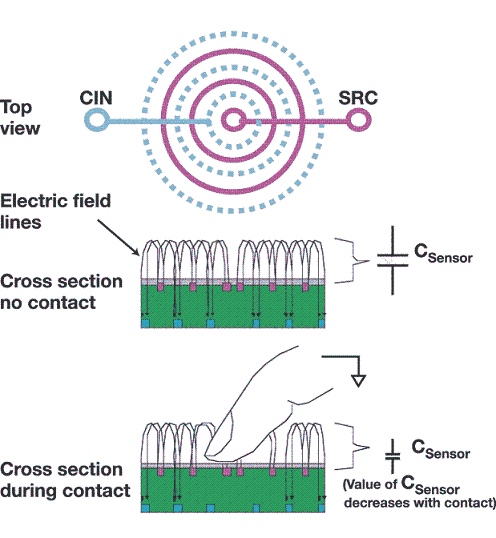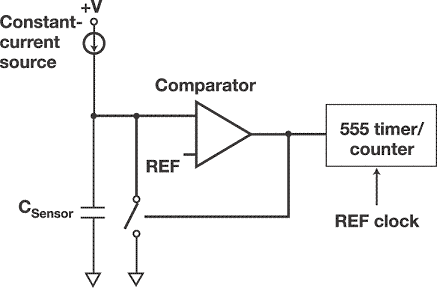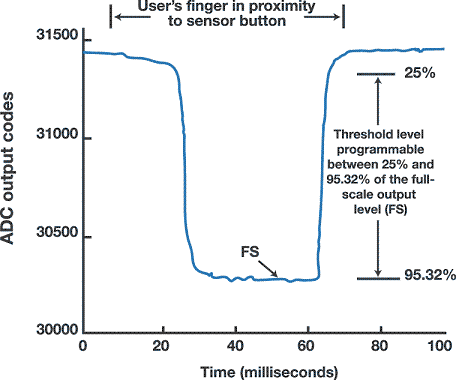Capacitive sensors typically have a capacitance range of 50fF to 20pF, making it difficult to accurately detect small capacitance changes, requiring a suitable analog interface. As with traditional mechanical switches, the user's experience with capacitive sensors is directly related to the sensitivity of the sensor's response to contact under various reliability conditions. This article describes some of the most common capacitive sensor front-end measurement techniques currently in place to develop high-quality and reliable capacitive sensor interfaces.
This article refers to the address: http://
The sensitivity of a capacitive sensor is determined by its physical design, the method used to measure the capacitance, and the ability to accurately compare capacitance changes relative to preset contact threshold levels.
Capacitive sensors fabricated using traditional printed circuit board processes typically have capacitance values ​​in the range of 50fF to 20pF, making it difficult to detect small changes in capacitance. Although there are several ways to measure these small values, the benefits of using high-precision measurement techniques with 16-bit capacitive-to-digital converters are significant.
Capacitive sensors can be designed on traditional low-cost printed circuit boards, or they can be developed on standard printed circuit boards or flexible printed circuits using the same copper as signal traces. In both cases, the maximum sensitivity of the sensor is determined by the physical dimensions of the sensor and the dielectric constant of the plastic screen printing compound, including the dissipation factor, the thickness of the silk screen material. For example, a 3 mm diameter sensor with a 5 mm plastic silk screen is less sensitive than a 6 mm diameter sensor with a 2 mm plastic silk screen.
The goal is to develop capacitive sensors that respond correctly and meet human environmental requirements. In some applications, the sensor may be small in shape, and as a result, the change in capacitance caused by user contact is also small. Figures 1 and 2 depict a general method of designing a capacitive sensor on a circuit board.

Figure 1: Capacitive sensor design with field structure in mind.

Figure 2: Another capacitive sensor design method.
The figure above shows the behavior of the sensor under excitation when the user touches the sensor. In both methods, the sensor capacitance varies depending on the user's contact; however, the performance of the sensor is comparable in both cases.
Excitation capacitive sensor
The example in Figure 1 applies a continuous 250 KHz excitation square wave to the source (SRC) of the sensor to establish the electric field of the capacitive sensor. The electric field created in the sensor is excited to pass through the silk screened plastic. The capacitor input (CIN) is connected to the input of the capacitance-to-digital converter.
Another example of a capacitive sensor design is shown in Figure 2. Apply a constant current source to port A of the sensor and port B to ground. When the user touches the sensor, the finger capacitance is superimposed. As a result, the RC rise time during the charge cycle is increased.
Measuring the contact between the capacitive sensor and the detection sensor
The traditional method of measuring capacitance is shown in Figure 3.

Figure 3: The traditional method of measuring capacitance is to use a comparator and a 555 counter.
The constant current source continuously charges the capacitive sensor to the reference threshold level of the comparator. Whenever the capacitive sensor reaches the reference threshold level, the comparator goes high; this high level turns off the switch, discharges the capacitor and resets the counter, as shown in Figure 4.

Figure 4: Sensitivity threshold levels for conventional comparators and 555 timer/counters.
By counting the number of clock cycles used by the capacitive sensor to charge the reference level (REF) on the comparator, the time the user touches the sensor can be determined. This value is then compared to a preset threshold detection setting, for example, a count value of 50 indicates sensor contact; and a count value less than 50 may indicate no contact. In this example, when the user touches the sensor, the accuracy and accuracy of the measurement is related to the frequency of the reference clock and to the repeatability of the current source over a wide range of capacitive sensor values.
The best way to measure capacitance is shown in Figure 5, which uses a high-resolution 16-bit analog-to-digital converter (ADC) and a 250KHz excitation source.

Figure 5: Analog Front End for the AD7142.
The excitation source is a continuous output 250KHz square wave that establishes an electric field and a power line that traverses the silk screen material in the capacitive sensor. Whenever the user touches the sensor, the precision 16-bit ADC is capable of detecting at 1fF measurement resolution. No adjustments are required with external components, and the automatic calibration function ensures that there is no malfunction due to temperature or humidity changes or that some touches are not counted.
After the output data of the capacitive sensor is digitized, the detection threshold level of each sensor can be conveniently programmed separately by setting the corresponding 16-bit register. The threshold level can be programmed to approximately 25% and 95.32% of the sensor full-scale (FS) output value, as shown in Figure 6.

Figure 6: Setting the AD7142 sensitivity gate limit level.
Reliable capacitive sensors are derived from analog front ends, which must measure small output changes caused by user contact with capacitive sensors. The new highly integrated capacitor-to-digital converter integrates a high-performance analog front end with low-power, high-resolution sigma-sigma converters, enabling capacitive sensor system design engineers to benefit from the latest advances in mixed-signal technology .
Nife Battery,48V 800Ah Nife Battery,Ni-Fe Battery 700~1200Ah,Ni-Fe Battery 700~1200Ah
Henan Xintaihang Power Source Co.,Ltd , https://www.taihangbattery.com